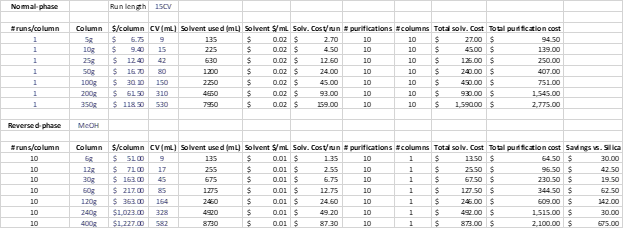For many labs on a tight budget, keeping expenses at a minimum is crucial. Many of these same labs are also required to become more sustainable, or greener, by reducing the amount of organic solvent they use. Reducing solvent also reduces expenses, but what is the impact on lab productivity?
One way to achieve the green initiative is to use reversed-phase flash chromatography instead of normal-phase since reversed-phase uses water (de-ionized or distilled) and either methanol or acetonitrile, all of which most labs already use. However, with reversed-phase columns costing more than normal-phase (silica) columns, is there any financial savings from converting to reversed-phase?
Well, the answer is yes, but depends on the organic solvent used with reversed-phase – methanol is relatively inexpensive at about $0.01/mL while acetonitrile is ~ $0.06/mL. Also, reversed-phase columns are reusable while silica columns should be used only once, then discarded. So, the more times you use a reversed-phase flash column the more money is saved for the lab.
In Table 1 you can see the cost comparison in back & white. For the calculations, we assumed a total method length of 15 column volumes (CV) including equilibration (2 CV). Solvent costs were based on what we pay here in Charlotte; hexane and ethyl acetate cost $0.02/mL, DCM is $0.03/mL, methanol $0.01/mL, acetonitrile $0.06/mL. Water is essentially free when sourced from a lab deionizer.
Table 1. Normal-phase vs. reversed-phase cost comparison

At 10 runs per column, easily achievable, reversed-phase flash chromatography using methanol/water methods starts to pay dividends vs. normal-phase (pretty much regardless of solvent choice). With acetonitrile/water, however, there is a longer payback period (30+ runs per column), depending on the column size.
For me, I use methanol whenever possible with reversed-phase but if a purification can’t be accomplished with methanol, I will use acetonitrile. In doing so, I reduce my lab’s costs as well as its carbon footprint.
Interested in learning more about reversed-phase? Click here.

